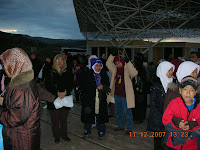 Breathtakingly picturesque, takes my breath away, I am simply enchanted, transported to another world!
Breathtakingly picturesque, takes my breath away, I am simply enchanted, transported to another world!So much happening in Cappadocia, that I have decided to break this particular leg of journey into several parts...simply because there is so much to see...to tell...to share..
The four of us rose very early in morning with the high spirits, and high hopes to go on the hot air balloon ride across Cappadocia. Alas, despair awaits us when Enis announced to the 7 of us (us foursome, Hj Kamaruddin and wife, and Toke Tayar), that the winds were too strong for a safe flight. What? Too strong winds unsafe? I would have thought it to be ideal for flying in a hot air balloon. I was to be educated. When the winds are too strong, I am told, it is almost impossible to raise the hot air balloon on air, let alone stopping it from drifting into unchartered territories once the strong wind takes over. Okay, I am enlightened...but still frustrated. Then Enis announced that we would have another try the following day. I remain optimistic.
So, once again, it was back to picture snapping around the hotel grounds. The rather barren surrounding and grey December skies did not dampen our photo snapping spirits, until a rather menacing deep growl from the long grass across the hotel brought Jua and I scurrying back to the safety of the hotel grounds.


The hotel in Cappadocia and its quiet surroundings
The first place of visit here was the to Cappadocia itself - The Valley of Beautiful Horses. We were taken to the Valley of Goreme, where the sight was simply breathtaking. The beauty of the stone carved houses was a sight to behold. Originally built by the Hittites (?), they were then occupied by the Christians in hiding. Pointed chimneys with smoke coming out from the underground homes earned them the name "Fairy Chimneys" by the locals. More popularly known now as Flintstone Houses.
History has it that more than 70 million years ago, there were 3 volcanoes surrounding this area - Egeas, Hasan and Gulu which continually spilled lava ashes and tufa(smoke). In the 20 million years, these ashes settled to become present day Cappadocia. Erosion and rain eventually caused the outer edges of the high plateau to be eroded off leaving valleys with sharp pointed highlands - conical shape mounts more like. This process of outer edge erosion by rain and wind still continue on to this day. Thus it is expected that the present panorama would change yet again over the years to come. But what stands in front of my eyes now was a uniquely, breathtaking view of God's earth...Allah's creation. I let the pictures speak for themselves.



History has it that more than 70 million years ago, there were 3 volcanoes surrounding this area - Egeas, Hasan and Gulu which continually spilled lava ashes and tufa(smoke). In the 20 million years, these ashes settled to become present day Cappadocia. Erosion and rain eventually caused the outer edges of the high plateau to be eroded off leaving valleys with sharp pointed highlands - conical shape mounts more like. This process of outer edge erosion by rain and wind still continue on to this day. Thus it is expected that the present panorama would change yet again over the years to come. But what stands in front of my eyes now was a uniquely, breathtaking view of God's earth...Allah's creation. I let the pictures speak for themselves.























































